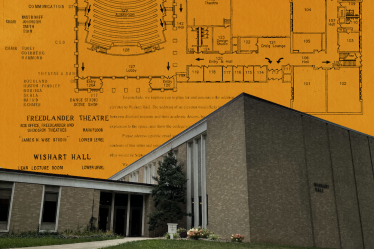Helen Oriatti-Bruns
Chief Copy Editor
On Thursday, April 24, David Jones ’88, vice president for finance and business, hosted an all-campus budget meeting. Jones provided updates on Wooster’s forecasted budget deficit for fiscal year 2025 and on the College’s financial projections for fiscal year 2026.
According to Jones, the College currently forecasts a $3.5 million deficit for 2025. Jones noted that this deficit was $2.1 million less than the amount approved for the 2025 budget, but that it was $3.5 million more than last year — as the College was able to draw on the endowment in 2024 to complete the year without a deficit.
“What my team is working on … is what I call ‘close the gap actions,’” Jones said. “We’re continuing to obviously turn over a lot of stones on expense structure and how we’re spending money … and that’s going to become a really important part of our DNA as an institution.”
Jones said that the College’s financial situation is “not all doom and gloom,” mentioning that the College recently received an A1 rating from the credit rating service Moody’s. A1 is one of Moody’s higher ratings and suggests that the College has the capacity to repay debt, but is subject to fluctuations in the economy. According to Jones, one of the College’s most significant challenges is decreasing enrollment.
The finance and budget team currently forecasts that enrollment will be at around 1,557 full-time students in fiscal year 2026 — a decrease of 20% from the average enrollment in fiscal years 2015 through 2023.
Jones attributed this decline partly due to what he described as the ‘enrollment demographic cliff’ — fewer babies were born from 2007 to 2010 due to the 2008 financial crisis, which will result in fewer students graduating from high schools in upcoming years. Additionally, per Jones, fewer high school students are choosing to attend college. Jones is working with Jason McGrath, vice president for enrollment, and Alexa Konstantinos, vice president for marketing and communications, to boost enrollment.
“Our relative engagement in terms of working with the enrollment office — helping the campus driving positivity around Wooster, the rebranding activities that Alexa [Konstantinos] and her team are doing — are really crucial to this institution,” Jones said.
On average, Wooster students receive a 70% discount on the total cost of attendance, amounting to around $60 million awarded to students. Jones stated that the College needs to “be mindful of how much discount in price we can afford” when calculating future students’ financial aid.
According to Jones, increasing enrollment is crucial to minimizing the College’s budget deficit. Jones’ team created long-range financial models and analyzed the impact of the “Framing Our Future” strategic initiatives — according to Jones’ financial models, if these initiatives gradually increase enrollment, the College will have surplus revenue by fiscal years 2029 and 2030. Jones stated that these initiatives involve frequent re-evaluations of costs while balancing the needs of students, faculty and staff.
“You know, one of the things I’ve been trying to gear myself to — and [President Anne McCall] and I were just talking about it — is the marathon perspective of higher education,” Jones said. “We’ve got some bumps to overcome, but we’re going to have to pace ourselves and again, make sure you’re making the right trade-offs between the Wooster experience and the Wooster mission.”

